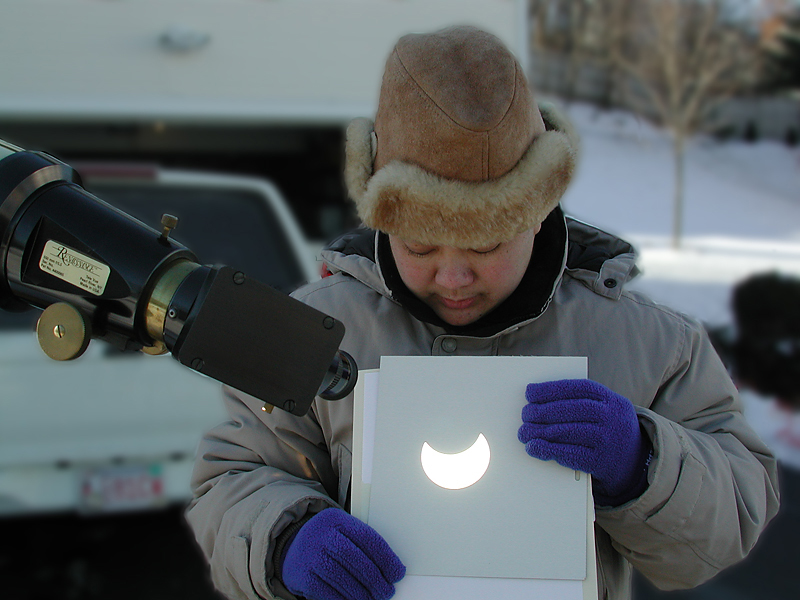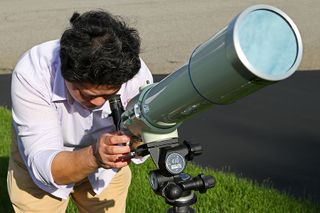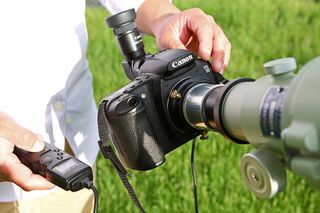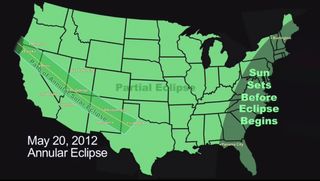How to Safely Observe Sunday's Solar Eclipse

Editor's Note for July 2017: The total solar eclipse of Aug. 21, 2017 will the THE skywatching event of the year, crossing 14 U.S. states as it makes its way from Oregon in the west to South Carolina in the east. Visit our complete coverage for the Great American Solar Eclipse for the latest eclipse news, complete viewing guides and best apps like Eclipse Safari to make the most of your eclipse viewing experience.
With a potentially spectacular solar eclipse to grace the skies of the western United States on Sunday (May 20), here's a helpful reminder for new eclipse chasers: Be safe. A fraction of a second of magnified, unfiltered sunlight will sear your eye’s retina irreparably.
Imagine a horrible sunburn on your eyeball. Your eye cannot grow new layers and slough off the singed ones like your skin tissue can, so staring directly at the sun is dangerous without the protection of safety equipment used by veteran skywatchers and astronomers.
So, practice Safe Sun: Don't ever look directly at it! Not with your eyes, binoculars, and certainly not with a telescope unless you have proper optical filters. Whether there's a solar eclipse or not, direct sunlight harms eyesight.

Warning: Sunday's solar eclipse is dangerous!
Solar eclipses such as annular eclipse on Sunday can be treacherous for the inexperienced. A ring ("annulus") of the sun's disk remains in view even at the moment of maximum coverage by the moon. Your eye's iris will be fooled by the relative darkness of the moon's silhouette. But dangerous direct sunlight appears around the edges and can hurt you badly without precautions. [Solar Eclipse of May 20, 2012 (Photo Guide)]
Experienced eclipse chasers watching a total solar eclipse will have a short time — during totality only — when they may view the eclipse directly. Don’t try this unless you are with someone who has done it before and can still see. But don’t try it at all under Sunday's annular solar eclipse.
Get the Space.com Newsletter
Breaking space news, the latest updates on rocket launches, skywatching events and more!

Safe sun observing
If you’re planning to watch a solar eclipse or look for sunspots, what is the proper optical filter material for sun-watching?
Eclipse glasses are designed and marketed for exactly this purpose. Shop them online if you have time before the event you’re planning to watch. Your local museum store may stock them. Try and buy them online from a reputable telescope maker (e.g., Orion, Meade, Celestron).
If you can get hold of them, welder's goggles rated at 14 or higher will protect your vision. The nice thing about goggles as opposed to glasses: They have straps. They’re not likely to fall off. Less safe is to hold a piece of No. 14 welder's glass up to the sun.
Seasoned eclipse observers and astronomers who know what they’re doing sometimes use aluminized Mylar sheeting. The aluminum residue blocks much of the harmful infrared and ultraviolet light. But be sure the material really is aluminized Mylar. And don't use it to jury-rig a filter over binoculars, telescopes or any other kind of lens-based or mirrored device.

Despite what you may have heard, DO NOT USE PHOTOGRAPHIC FILM — especially not medical X-rays that you may have around. While there are some emulsions which, when developed after being fully exposed, can make effective filters, it is very difficult to know if the film stock you have will be safe.
Only black and white film made with a silver emulsion, fully exposed and fully developed, can be used, and only if you are absolutely sure. Color films are never safe.
Other "Unsafe for Sun" filters include smoked glass, brown or green glass (think beer bottles), polarized sunglasses /car windshields or "neural density" filters for cameras. Just because the sun looks dark through the substance does not mean that perilous invisible infrared light or hazardous ultraviolet light is not reaching your delicate retina. [How to Look at the Sun and Not Go Blind (Infographic)]
Pinhole camera/projector and telescope — pinhole projector
The safest way to view solar eclipses using items you probably have at home is to build a pinhole camera. Our colleague Natalie Wolchover of Life's Little Mysteries gives you complete, easy-to-follow pinhole camera instructions in this video.
If you have a telescope, make sure to get the correct solar filter for it. An unfiltered telescope pointed at the sun is very dangerous, even if no one looks through it. It can start fires in seconds. [Remember those unfortunate ants the neighbor kid incinerated with his magnifying glass?]
The right filter is not only very dark at most wavelengths; it tightly grips the optical tube — or the first element in the light path — so that it can’t be knocked off.
Also, remember to remove your finder scope or any other secondary magnifier. Even if capped, these can get hot in extended sunlight and easily warp or crack.
But if your finder scope is off, how to you align your telescope to that big bright star you want to see? Simple: look at the shadow in the ground. Move your scope around until the shadow’s footprint is smallest. Now you’re perfectly on the sun!
To see these tips in action, watch this video on observing the sun with a telescope.
See the sun online
Of course, the sun is always available online. NASA's Solar Dynamics Observatory — in geosynchronous orbit — has a better view than you and I will ever get. This smart spacecraft keeps itself pointing on the sun, down-linking 130MB of science data every second. NASA's Goddard Space Flight Center publishes SDO’s stunning images to an interactive online player. You can zoom in on active regions, fly across the flares silhouetted off the sun’s limb, spot solar tornadoes … Our star's surface is a fascinating and frightening place.
NOTE:The Solar Dynamics Observatory will not be in a position to "see" the May 20 annular eclipse. Neither NASA's Solar Terrestrial Relations Observatory nor the joint ESA/NASA Solar Heliospheric Observatory will see it, either. But the Japanese-U.S. Hinode satellite will catch four discrete partial eclipses during this time.

Final Warning
By the way, did I mention? Don't EVER stare directly at the sun! Not with your eyes, not with binoculars, certainly not with a telescope unless you have PROPER optical filters.
I practice Safe Sun. So should you.
Editor's note: If you snap any safe and amazing solar eclipse photos that you'd like to be considered for use in a story or gallery, please send images and comments to SPACE.com managing editor Tariq Malik at tmalik@space.com.
Follow SPACE.com for the latest in space science and exploration news on Twitter @Spacedotcom and on Facebook.
Join our Space Forums to keep talking space on the latest missions, night sky and more! And if you have a news tip, correction or comment, let us know at: community@space.com.
Dave Brody has been a writer and Executive Producer at SPACE.com since January 2000. He created and hosted space science video for Starry Night astronomy software, Orion Telescopes and SPACE.com TV. A career space documentarian and journalist, Brody was the Supervising Producer of the long running Inside Space news magazine television program on SYFY. Follow Dave on Twitter @DavidSkyBrody.
